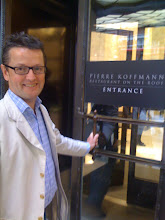

Some foodie friends from Suffolk were up in London recently, staying in Waterloo. They have just had a baby and this was their first evening off having put the baby in the care of a grandparent. They were particularly hungry and were keen to try out some local, cutting-edge metropolitan restaurant within easy reach of a panicking grandfather.
Well, the Anchor & Hope is not exactly cutting edge but it's an excellent place, about as good as (pub) food gets, the atmosphere is convivial if noisy, it's informal, and the dishes lend themselves to sharing.
Whilst contemplating the menu we had pints of well-kept Young's Ordinary (£3) and then kicked off with Quince and Prosecco fizz as an aperitif (£4.60) whilst sitting at the bar waiting for a table (there is a no-booking, first-come first-serve policy except on Sunday lunch). There were some tempting looking pâté-laden crostini on the bar which were slightly out of reach because of the sheer number of punters ordering drinks (Monday evening, around 7). The three of us were eventually shown to a tiny corner table which we knew would not be big enough for all the dishes we were going to order. But as soon as another larger table became free we were offered it graciously by the waiter (but carried over all the paraphernalia ourselves).

We tried Artichoke Vinaigrette (£4.80) which was what it said on the tin. Very plain, French home food but novel in a London restaurant. I had to show the Suffolktons how to peel the leaves and scrape the flesh off the ends using teeth. Whole Crab Mayonnaise (£8.40) again was what the tin said. And it was very sweet, fresh and juicy and the mayonnaise made in-house (why do Loch Fyne restaurants refuse to make their own mayo? grrrrr). Great diet food as it takes so long to pick out the meat that you end up ignoring other dishes. But we were too greedy for that and were soon tucking into Smoked Cod's Roe on Toast, Cucumber & Crème Fraîche (£6) which was just that and really good. The cream was probably unnecessary but the cucumber had been peeled, salted and then lightly pickled and went well with the salty fish.
Hot dishes were Salt Beef, Beetroot & Horseradish Broth (£5) which was very satisfying, the beef melting, the beetroot sweet and fruity, the horseradish cream giving the dish a kick; I could have had this one twice over and slightly resented having to share it. Red Gurnard, its Broth & Aïoli (£13.80) was OUTSTANDINGLY good, simpler and better than Bouillabaisse at a fraction of the price (please Chelseafish, don't tell me gurnard is on the endangered list).

Hare & Mashed Celeriac (£13.80) was well done, flaky but not dry leg meat on the bone in a winey jus with real depth. Could have had more juniper maybe but this went really well with the old fashioned, gamey, truffley, beetrooty 12 year old Rioja Alta Gran Reserva 904 which we managed to drink from real wine glasses as opposed to the ludicrously trendy Duralex school tumblers on other tables which do nothing for fine wine (St. John Restaurant please note).

Roast & Confit Mallard, Coco Beans, Kale & Damson (£28 for two) was cooked to perfection (but not very Delia) with really rare breast served on the carcase and the separate legs done confit, really tender, not too salty; shame that in France you never get breast AND leg served like this together. Roast Middlewhite, Pumpkin & Cured Ham, Bramley Apple Sauce (£16) was really sweet, moist, pale meat in a broth with soft, yielding ham. The apple was best avoided with the wine (as was the damson in the duck dish). Whole Roast Seabass (£32.80 for two) was off but that is a fish you can pick up off the beach in Suffolk and cook yourself quite easily and Slow Cooked Lamb Shoulder and Gratin Dauphinois at £65 for five-ish might have been a bit greedy.

However, there was room for puds (and cheese) and we chose the whole lot. Lemon Queen of Puddings (£5) was a lovely soft meringuey sort of thing and quite refreshing after the protein overload beforehand. Pear & Almond Tart (£5) was just that, Buttermilk Pudding & Scottish Raspberries (£4.80) a great way to neutralise some of the tartness of the fruit, Damson Icecream (£2.40 per scoop) damsomy, and the star Soufflé Beignet, Stewed Bramley & Vanilla Icecream (£5) which was perfectly crispily fried churros (not sure why chef Trish Hilferty chose a French name for these) with stewed apple. We had our Mr Creosote moment with the cheese (at £7.40, more than at Pierre Koffmann's but at least the cheese was at room temp and not fridge cold) and reluctantly ate it fearing detonation. It was served with a whole apple cut in half, but not peeled or cored, which somehow sums up the welcome lack of pretension of the Anchor & Hope.
As in so many restaurants however, wine service could have been better. Whilst the normal tumblers were replaced with wine glasses for the (£50) Rioja, this red wine whilst excellent was served too warm. The Viré Clessé 2005, André Bonhomme (£25) was noticeably corked but the waiter wanted to fetch a superior before accepting our mutual rejection of the wine. The second bottle was even worse at which point the manageress suggested we have something else; logically, we should have been offered a 3rd bottle. We settled for Limoux Chardonnay 2007, Toques & Clocher (£29) which was actually very good and coped more or less with the mix of starters. A fruity, spicey Douro 2007, Vinha de Palestra (£20 and again, too warm) helped the cheese go down. The list usefully serves six whites and five reds and one rosé by the 375ml carafe aswell as 125ml glass but if you want to smell the wine refuse the school canteen tumbler.













































